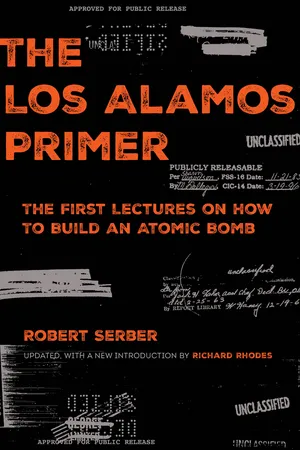![]()
The Los Alamos Primer
The following notes are based on a set of five lectures given by R. Serber during the first two weeks of April 1943, as an “indoctrination course” in connection with the starting of the Los Alamos Project. The notes were written up by E. U. Condon.
Everybody assembled in the big library reading room on the first floor of the Technical Area, the building where the theoretical physicists had their offices. We had a little blackboard set up in front and a lot of folding chairs spread around the room. Fifty people on hand, something like that. Scientific staff, a few visiting VIPs. There was hammering off in the background, carpenters and electricians working out of sight but all over the place. At one point during the lectures a leg came bursting through the beaverboard ceiling. One of the workmen misstepped and they had to pull him out.
1. Object
The object of the project is to produce a practical military weapon in the form of a bomb in which the energy is released by a fast neutron chain reaction in one or more of the materials known to show nuclear fission.
I started lecturing. I started talking about the “bomb.” After a couple of minutes Oppie1 sent John Manley up to tell me not to use that word. Too many workmen around, Manley said. They were worried about security. I should use “gadget” instead. In the Primer Condon wrote it down both ways. But around Los Alamos after that we called the bomb we were building the “gadget.”
Section 1 emphasizes that our purpose at Los Alamos was to build a practical military weapon—one small enough and light enough that an airplane could carry it.2 There was no use making something that weighed one hundred tons. That was our concern.
We meant to build this weapon by utilizing the energy from nuclear fission. Fission had a history. For a long time before 1939, people were bombarding uranium with neutrons. Uranium was the heaviest element known up to 1939. People had the idea that the uranium they were bombarding was capturing neutrons and transmuting to heavier elements, elements beyond uranium on the periodic table, transuranics. I remember seminars in Berkeley in the 1930s when the chemists discussed the trouble they were having explaining the chemistry of these supposed transuranic elements. The chemistry didn’t seem to be working out right. Then Otto Hahn and Fritz Strassmann, in Germany, working with the physicist Lise Meitner, found out that making transuranics wasn’t what was usually happening at all. Instead, the uranium nucleus was actually splitting into two big pieces, and doing it with the release of a great deal of energy (and a couple of extra neutrons, as several people soon demonstrated). As soon as that was discovered, everybody realized the possibility both of making weapons and of getting power.
Finally, the reaction we were interested in was a fast neutron chain reaction, which I’ll discuss later in these notes.
2. Energy of Fission Process
The direct energy release in the fission process is of the order of 170 Mev per atom. This is considerably more than 107 times the heat of reaction per atom in ordinary combustion processes.
In Section 23 we immediately come to the heart of the matter: that the energy released in the fission of the uranium nucleus is considerably greater than 107—that is, ten million times the energy released in a typical chemical combustion such as an explosion or a fire. All else follows from this fact. So we should try to understand where this large number comes from.
We can do so because the origin of the energy released in fission is exactly the same as the origin of the energy released when two atoms or molecules react chemically. It’s the electrostatic energy between two similarly charged particles. Two similarly charged particles repel each other. There’s an electrical force pushing them apart. Work has to be done to overcome that repulsion and push them together from a large distance, up to a point of separation we can call R.
To start with a simpler particle than an atom, let’s look at two electrons pushed together. If you released them, they would fly apart with an amount of energy equal to the work that went into pushing them together. That energy E is given by the formula
where e is the electron charge, e2 is e multiplied by itself, and R is the distance between the particles. The electrostatic energy thus ends up as kinetic energy, the energy of motion. In chemical reactions—the burning of hydrogen and oxygen in a rocket engine, for example—electrons bound in atoms or molecules change their positions, and the change in electrostatic energy is what appears as the energy of the chemical reaction.
Now let’s consider the electrostatic energy in the uranium nucleus. The uranium nucleus contains 92 protons, each of which has the same charge as an electron, though of opposite sign—particles of opposite sign attract each other, those of the same sign repel. So the uranium nucleus has a charge 92 times as great as an electron; it’s positive rather than negative, + rather than −, but since only the square of the charge is involved, that difference doesn’t matter in equation (1). The numerator of (1) is thus 922 times bigger than for a chemical reaction. For our purposes, 922 is close enough to call 1002. So the numerator for a uranium atom would be greater by a factor of 1002, 100 times ...

